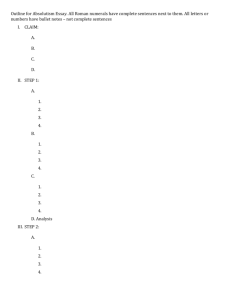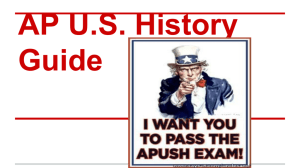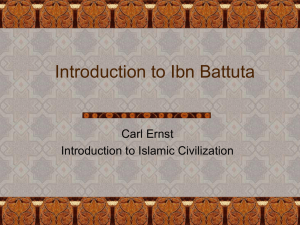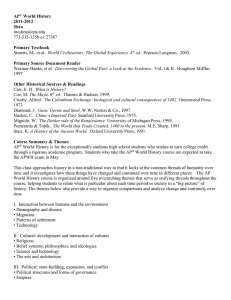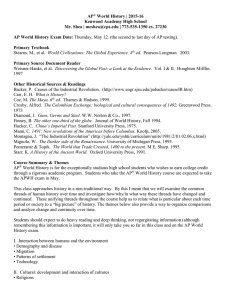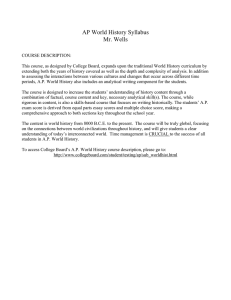Getting to know your textbook
advertisement
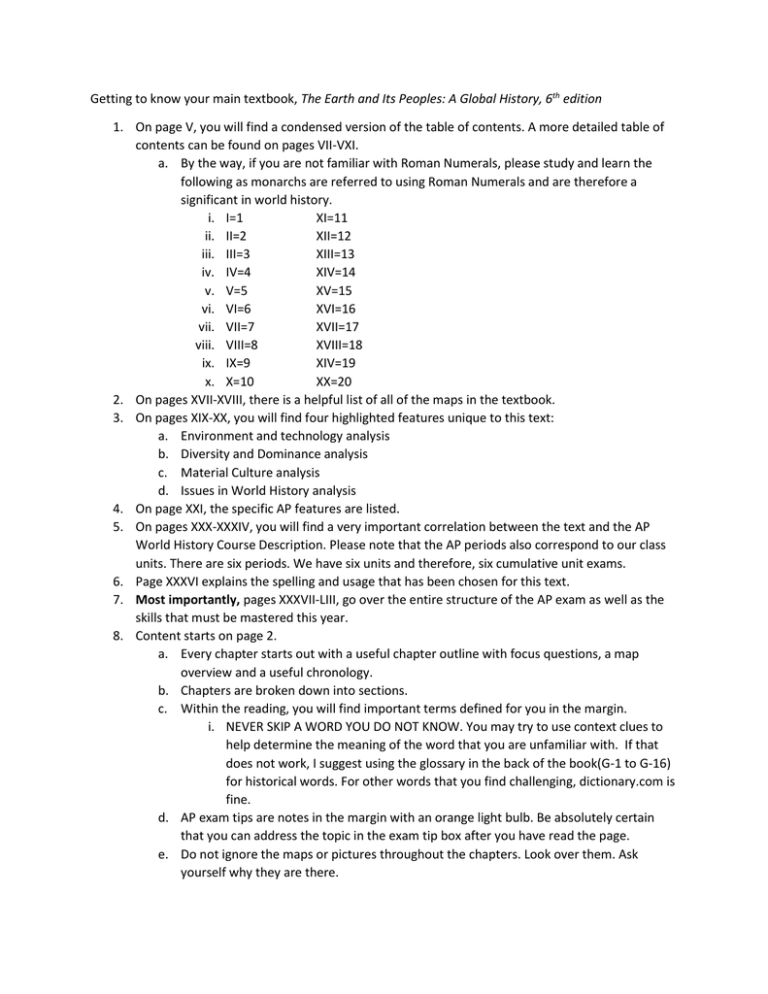
Getting to know your main textbook, The Earth and Its Peoples: A Global History, 6th edition 1. On page V, you will find a condensed version of the table of contents. A more detailed table of contents can be found on pages VII-VXI. a. By the way, if you are not familiar with Roman Numerals, please study and learn the following as monarchs are referred to using Roman Numerals and are therefore a significant in world history. i. I=1 XI=11 ii. II=2 XII=12 iii. III=3 XIII=13 iv. IV=4 XIV=14 v. V=5 XV=15 vi. VI=6 XVI=16 vii. VII=7 XVII=17 viii. VIII=8 XVIII=18 ix. IX=9 XIV=19 x. X=10 XX=20 2. On pages XVII-XVIII, there is a helpful list of all of the maps in the textbook. 3. On pages XIX-XX, you will find four highlighted features unique to this text: a. Environment and technology analysis b. Diversity and Dominance analysis c. Material Culture analysis d. Issues in World History analysis 4. On page XXI, the specific AP features are listed. 5. On pages XXX-XXXIV, you will find a very important correlation between the text and the AP World History Course Description. Please note that the AP periods also correspond to our class units. There are six periods. We have six units and therefore, six cumulative unit exams. 6. Page XXXVI explains the spelling and usage that has been chosen for this text. 7. Most importantly, pages XXXVII-LIII, go over the entire structure of the AP exam as well as the skills that must be mastered this year. 8. Content starts on page 2. a. Every chapter starts out with a useful chapter outline with focus questions, a map overview and a useful chronology. b. Chapters are broken down into sections. c. Within the reading, you will find important terms defined for you in the margin. i. NEVER SKIP A WORD YOU DO NOT KNOW. You may try to use context clues to help determine the meaning of the word that you are unfamiliar with. If that does not work, I suggest using the glossary in the back of the book(G-1 to G-16) for historical words. For other words that you find challenging, dictionary.com is fine. d. AP exam tips are notes in the margin with an orange light bulb. Be absolutely certain that you can address the topic in the exam tip box after you have read the page. e. Do not ignore the maps or pictures throughout the chapters. Look over them. Ask yourself why they are there. f. Some important words are in bold. Skimming the sentence before the bolded term and after is not enough. I will direct you to skim when I want you to skim. Otherwise, it is my expectation that you are READING TO LEARN! g. Sections end with a short bulleted review. This is material you must know from that day on until at least May 12th(hopefully forever)! h. Each chapter ends with a conclusion that usually compares very important topics that relate to possible comparative essay topics. i. You will also find a list of key terms at the end of each chapter. You must have a working knowledge of these. Make flash cards for the ones you do not remember after reading or for any you are not comfortable with. In other words, these terms should be in your long-term memory. j. For my scholars, there is an excellent list of suggested further reading if you discover a topic that intrigues you. k. There are also practice AP style multiple choice questions at the end of each chapter. We will often work on these by doing what I call “justified multiple choice” i. Example: page 39 1. 13. One of the major difficulties in understanding the Indus Valley civilization is that: a. There is a lack of artifacts(ridiculous! We have a plethora of artifacts that help us to understand the culture of the Indus Valley people) b. Archaeologists are not sure of the exact location(No way! We know they were located in modern day Pakistan) c. Its written language cannot be read(Yes, that is our problem. We have not found anything like The Rosetta Stone, which helped us to decipher hieroglyphics. Therefore, we have documentation, but we have no idea what it says. This is fascinating because if we ever find a key to their language, our interpretation of the past could be completely altered. d. All of its cities have been destroyed(No, this is wrong. Anyway, almost every answer that says all or none is usually wrong). l. The last part of each chapter are free response essays. We will learn the comparative essay in September and the CCOT in January. Therefore, you may only be able to list continuities and changes before winter break. But, it would be great if you went back to practice the CCOT prompts once we learn the essay format. You will be able to use the comparative prompt to practice your comparative essay writing skills. 9. The index starts on page I-I(after the glossary in the back). Look up people using their last name. For instance Marco Polo would be found under “P”. However, Ibn Battuta is found under “I” because his full name is Abu Abdullah Muhammad Ibn Battuta. 10. Quite possibly the best bonus of this book are the practice DBQ essays at the very end of your book(A-1 through A-44). Once we learn the DBQ in October, you will find these to be most helpful. You simply MUST READ THIS BOOK!!! Just like you MUST STUDY EVERY NIGHT!!! This class is like no other you have ever experienced. Please trust me. I know what it takes to pass this exam
